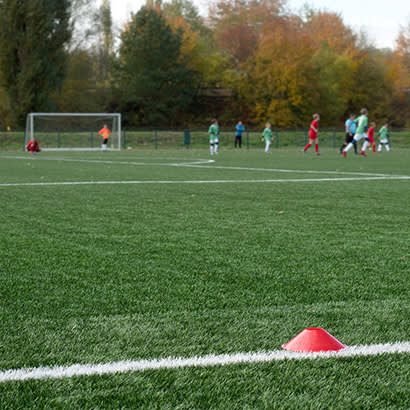
For an enhanced digital experience, read this story in the ezine.
Natural turfgrass areas are used extensively for recreation and provide places where adults, kids and pets can spend time outside the home. Managers of natural grass surfaces are responsible for proper maintenance activities to ensure the health and safety of these recreational areas. In 2020, Sports Field Management Association (SFMA) released a Route to Recovery Guide, as well as part two of the Route to Recovery Guide, that covers many topics that can help guide staff through field maintenance concerns. These guides address many of the challenges that maintenance staff may encounter with fields that have not been maintained.
Here are some of the most critical practices to use to get your field back in shape:
Mowing
A standard rule in the industry for moderately to intensively maintained turfgrass is to never remove more than one-third of the grass blade in a single mowing. Removing more than this results in physiological stress and possible heat or cold injury. If the athletic field was not mowed and excessive growth occurred, the field should slowly be brought back down to the normal height. This may take several weeks or months depending on growth levels.
Fertilization
When grass is actively growing is the ideal time to optimize the turfgrass response to a fertilizer application. Soil test results will tell you how much fertilizer to apply for nutrients other than nitrogen, and while many soil test reports will not contain soil nitrogen levels, they will provide a recommendation for how much nitrogen to apply and when to treat. As a rule of thumb, most state extension recommendations suggest readily available nitrogen (water-soluble) should be in the range of 0.7 to 1 pound of nitrogen per 1000-square-feet per active growing month.
Irrigation
Turfgrass plants need an inch of moisture per week to sustain active growth. If irrigation is an option, the field may need more frequent irrigation during the recovery period. This will help reduce stress related to the turfgrass being brought back down to the proper height, as well as reduce heat and drought stress. Similarly, if some spots on the field need seed, you may need to supply water from irrigation in frequent small amounts while the seed germinates.
Weed Management
A playing surface covered in weeds can disrupt the appearance and safety of maintained turfgrass surfaces. In addition, weeds compete with desired turfgrasses for space, water, nutrients and light. If weed populations have exceeded the threshold set in your integrated pest management plan, consider finding the best herbicide to control the weeds present at your facility. Make sure to read and follow the label for control of these weeds, especially if there are temperature restrictions on the label.
Field recovery may seem like an insurmountable task in front of you, but once regular maintenance resumes, many of these practices will quickly become routine. Communicate with end users regularly about the importance of getting field maintenance under control before resuming use. Using a field prematurely will cause excessive wear and damage, resulting in an unsafe playing surface. Also, don’t forget to reach out to SFMA members for advice on various questions that may pop up, as they are probably working through the same issues as you are.
Editor’s Note: This article originally appeared on Open Space Blog in June 2020 and has been edited for length. Representatives of the Sports Field Management Association contributed to this article.
James Bergdoll, CFSM, is Director of Parks Maintenance at City of Chattanooga Public Works. Adam Thomas, Ph.D., is with Iowa State University. Grady Miller, Ph.D., is with North Carolina State University. Nick Christians, Ph.D., is with Iowa State University.

